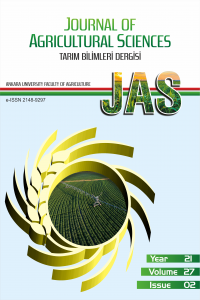Genetic Diversity and Population Structure of Fusarium oxysporum f. sp. cepae, the Causal Agent of Fusarium Basal Plate Rot on Onion using RAPD Markers
A total of 116 single spore isolates of Fusarium oxysporum f. sp. cepae representing seven populations from Turkey and one population from Colorado, USA were subjected to molecular marker analysis using Random amplified polymorphic DNA (RAPD) technique. Using eleven polymorphic primers, 110 RAPD fragments were obtained with an average of 10 polymorphic bands per primer. Cluster analysis with UPGMA revealed five distinct lineages at arbitrary level of 65% similarity. The majority of F. oxysporum f. sp. cepae isolates from Turkey were observed to derive probably from the same clonal lineage. Genetic estimates and population differences demonstrated that the isolates from Turkey were significantly distinct from Colorado isolates and that Bursa population was the most divergent among Turkish populations. Cluster analysis of Nei's genetic distances supported populations grouping according to the geographical regions. Comparison of genetic differentiation estimates (HT: 0.140, HS: 0.124) revealed low levels of genetic differentiation among Turkish populations. Only, 11.4% of total genetic diversity (GST) attributed to differentiation among the geographical populations. Analysis of molecular variance (AMOVA) confirmed that there was low genetic differentiation among populations. The results suggest that RAPD-PCR is a useful method for analyzing genetic variation within and between populations of F. oxysporum f. sp. cepae.
Anahtar Kelimeler:
-, genetic, population
Genetic Diversity and Population Structure of Fusarium oxysporum f. sp. cepae, the Causal Agent of Fusarium Basal Plate Rot on Onion using RAPD Markers
A total of 116 single spore isolates of Fusarium oxysporum f. sp. cepae representing seven populations from Turkey and one population from Colorado, USA were subjected to molecular marker analysis using Random amplified polymorphic DNA (RAPD) technique. Using eleven polymorphic primers, 110 RAPD fragments were obtained with an average of 10 polymorphic bands per primer. Cluster analysis with UPGMA revealed five distinct lineages at arbitrary level of 65% similarity. The majority of F. oxysporum f. sp. cepae isolates from Turkey were observed to derive probably from the same clonal lineage. Genetic estimates and population differences demonstrated that the isolates from Turkey were significantly distinct from Colorado isolates and that Bursa population was the most divergent among Turkish populations. Cluster analysis of Nei's genetic distances supported populations grouping according to the geographical regions. Comparison of genetic differentiation estimates (HT: 0.140, HS: 0.124) revealed low levels of genetic differentiation among Turkish populations. Only, 11.4% of total genetic diversity (GST) attributed to differentiation among the geographical populations. Analysis of molecular variance (AMOVA) confirmed that there was low genetic differentiation among populations. The results suggest that RAPD-PCR is a useful method for analyzing genetic variation within and between populations of F. oxysporum f. sp. cepae.
Keywords:
-,
- ISSN: 1300-7580
- Yayın Aralığı: Yılda 4 Sayı
- Başlangıç: 1995
- Yayıncı: Ankara Üniversitesi
Sayıdaki Diğer Makaleler
Buğday, Arpa ve Çavdar’da Girdi Talebi: Erzurum Örneği
Geleneksel ve Pençesiz Sağım Sistemlerinin Vakum Dinamiklerinin Karşılaştırılması
Hülya ÖZ, Sandra ROSE-MEIERHÖFER, Ulrich STRÖBEL, Christian AMMON
Taze Đncir Meyvesinin Taşınması Sırasında Oluşan Kalite Kaybının Değerlendirilmesi
Bülent ÇAKMAK, Fazilet ALAYUNT, Cengiz AKDENİZ, Zafer CAN, Uygun AKSOY
